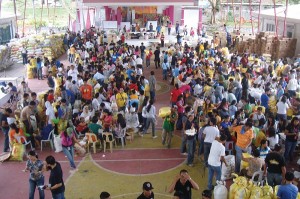
FILE PHOTO
DAVAO CITY — The resumption of classes this January will not be the usual return from the holidays for children here, when schools and Early Childhood Care and Development (ECCD) centers re-open after the Christmas break. Thousands of children will continue to be displaced with up to 95% of school buildings, classrooms and day care centers damaged or destroyed in the four most affected provinces following Typhoon Pablo in Mindanao, Philippines. Consequently, these children have no school buildings, interrupting their education.
More than 600 schools and 170 day care centers were destroyed or damaged. The right of evacuees to be housed in safe accommodation is fully recognized. This has to be realized while simultaneously fulfilling the right of children’s access education.
Classes resumed on January 3 for both elementary and secondary schools. Children were given informal sessions (psychosocial support involving games, drawing, singing, dancing), until January 14 when formal academic classes started. This will also give people time to re-locate, for teachers to track children, and for schools and classrooms to be repaired and cleaned up.
Plan International, Save the Children, World Vision and UNICEF, the four child-focused agencies, highlight the critical importance of education and early childhood care in emergencies. The following joint statement highlights this urgent issue in more detail.
Background
Of the total 6.2 million people affected by Typhoon Pablo, 2.3 million were estimated to be children under 18 years old. For the 700,000 people most affected in the 3 provinces most seriously damaged by Typhoon Pablo (Davao Oriental, Compostela Valley and Agusan del Sur), an estimated 294,000 are children. In any emergency, children are one of the most vulnerable groups. They are highly vulnerable to dropping out of school or discontinuing attendance of day care sessions.
As the effects of the typhoon continue to become more apparent, threats to education of the affected populations are high. Children’s right to education should not be given any lower priority compared with other critical needs in the aftermath of Typhoon Pablo in view of its life-saving and life-sustaining nature.
Education in Emergencies
The four child-focused agencies urge all government agencies, local representatives and communities and humanitarian partners to pay particular attention to the needs and rights of children in emergencies including but not exclusive to the following:
· Education, including ECCD opportunities, should be seen as a primary component of an initial humanitarian response, along with other emergency response interventions. The rhythm of schooling and being able to interact with other children is essential for children to regain a much-needed sense of routine, stability, structure and hope for the future, which in turn is critical for their psychosocial recovery.
· Disasters disrupt the schooling of children and adolescents. Children and adolescents may get involved in hazardous work; become vulnerable to the risks of trafficking and early marriage; and later on be forced to drop out from school. When a child is in a safe learning environment, he or she is less likely to be exposed to these risks. In addition, education can convey life-saving information to strengthen critical survival skills and coping mechanisms such as protection from violence and abuse including trafficking and sexual exploitation and essential health/sanitation/hygiene information.
· Schools should only be used as evacuation centers as a last resort and for the shortest possible time. In situations when schools have been destroyed or damaged, or when schools are used as evacuation centers for longer periods of time, children’s right to education should be promoted by setting-up Temporary Learning Spaces, which includes training teachers on how to run these spaces, providing back-to-school kits and teaching-learning kits.
· Temporary Learning Spaces are also used as a convergence point for other services especially those provided by Education, Child Protection, WASH, Health and Nutrition and Shelter Clusters. Temporary Learning Spaces include psychosocial support and awareness sessions on child and adolescent protection (including gender-based violence) and health (including proper nutrition and adolescent sexual and reproductive health). All Temporary Learning Spaces must have access to water and sanitation services including separate latrines for boys and girls.
· Apart from physical support, the immediate psychosocial support services for all displaced and affected education workers in the worst-hit areas is also critical to help them recover from stress. In turn, this will enable them to restore the learning environment for affected children.
· Setting up of Temporary Learning Spaces, and planning the provision of necessary back-to-school supplies is being undertaken.
· Plan International, Save the Children, World Vision and UNICEF will continue to work closely with the Philippine Government, the Department of Education and other humanitarian partners who, with their commendable efforts, are addressing the urgent and pressing needs of children in emergencies.